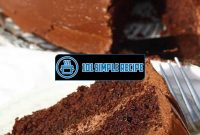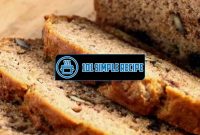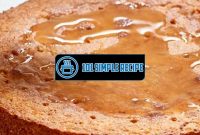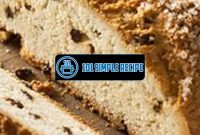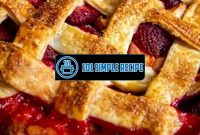Looking for a delicious gluten-free Irish soda bread recipe to enjoy with your St. Patrick’s Day feast? Well, look no further! This traditional Irish recipe has been given a gluten-free twist, allowing those with dietary restrictions to indulge in this beloved baked treat. With its crispy crust and soft, slightly sweet interior, this gluten-free soda bread is sure to be a hit at your next gathering. So, grab your apron and get ready to bake a loaf of this mouthwatering bread that will transport you straight to the Emerald Isle.

The Rise of Gluten-Free Irish Soda Bread
Discover the fascinating history and growing popularity of gluten-free Irish soda bread.
Origins of Irish Soda Bread
Irish soda bread has a rich history dating back centuries. It originated in Ireland during the 19th century and quickly became a staple in Irish households. The traditional recipe calls for just a few simple ingredients – flour, baking soda, salt, and buttermilk. The absence of yeast in the recipe is what gives soda bread its unique texture and taste.
Fun Fact: The slightly tangy flavor of soda bread comes from the reaction of the buttermilk with the baking soda.
Originally, Irish soda bread was made with regular wheat flour. However, with the rise in gluten sensitivities and celiac disease, the demand for gluten-free alternatives has grown exponentially in recent years.
The Gluten-Free Movement
The gluten-free movement has gained significant traction in the past decade, with more and more people opting for gluten-free diets. Gluten, a protein found in wheat, barley, and rye, can cause digestive issues and discomfort for those with gluten sensitivities or celiac disease.
Important Note: Celiac disease is an autoimmune disorder where the consumption of gluten triggers an immune response that damages the lining of the small intestine.
As awareness about the negative effects of gluten spread, food manufacturers and bakeries began developing gluten-free alternatives to traditional wheat-based products. This led to the rise of gluten-free baking and the adaptation of classic recipes, such as Irish soda bread, to accommodate those with dietary restrictions.
Adapting Irish Soda Bread for Gluten-Free Diets
Adapting Irish soda bread for gluten-free diets presented some challenges. Wheat flour, which contains gluten, is the main ingredient in traditional soda bread recipes. However, with the availability of gluten-free flours and baking substitutes, it became possible to create a delicious gluten-free version of Irish soda bread.
Note: Commonly used gluten-free flour substitutes include rice flour, almond flour, and sorghum flour.
When making gluten-free Irish soda bread, it is important to choose the right combination of gluten-free flours to achieve the desired texture and taste. Some recipes may call for xanthan gum or other binding agents to mimic the elasticity of gluten.
Fun Fact: Gluten-free Irish soda bread often has a slightly denser texture compared to its wheat-based counterpart.
In conclusion, the rise of gluten-free Irish soda bread is a testament to the growing demand for gluten-free alternatives and the ingenuity of bakers in adapting traditional recipes. Whether you have celiac disease or simply choose to follow a gluten-free diet, you can now enjoy the delicious taste of Irish soda bread without the worry of gluten. So, next time you’re craving a slice of this traditional Irish treat, why not try a gluten-free version?
Whole Foods Chantilly Cake Recipe
The Science Behind Gluten-Free Irish Soda Bread
When it comes to creating a delicious and nutritious gluten-free Irish soda bread, understanding the science behind it is key. By exploring the key ingredients and techniques involved, you can ensure that your bread turns out both flavorful and gluten-free.
Understanding Gluten Sensitivity
Gluten sensitivity is a condition where individuals experience adverse reactions to the protein gluten, which is found in wheat, barley, and rye. This sensitivity can cause a range of symptoms, including digestive issues, fatigue, and even joint pain. For those with gluten sensitivity, consuming foods containing gluten can be detrimental to their overall health and well-being.
By opting for a gluten-free version of Irish soda bread, individuals with gluten sensitivity can still enjoy this traditional treat without the negative side effects. The key is to use alternative flours that are free from gluten.
The Role of Alternative Flours
When it comes to making gluten-free Irish soda bread, the choice of alternative flours is crucial. Traditional soda bread is typically made with all-purpose flour, which contains gluten. However, by substituting this with alternative flours, you can create a gluten-free version that is just as tasty.
Popular choices for alternative flours in gluten-free baking include rice flour, almond flour, and oat flour. These flours provide a similar texture and taste to traditional wheat flour, making them suitable for creating delicious gluten-free bread. Moreover, these flours also offer added nutritional benefits, such as being high in fiber, protein, and healthy fats.
In addition to alternative flours, incorporating other gluten-free ingredients into your bread can further enhance its flavor and texture. For example, adding xanthan gum can help bind the ingredients together and create a bread that is less crumbly.
Substituting Ingredients for Gluten-Free Versions
Aside from choosing alternative flours, substituting certain ingredients in the recipe can also contribute to a successful gluten-free Irish soda bread. These substitutions ensure that the bread is devoid of any hidden sources of gluten.
One key ingredient to swap out is baking powder. While most baking powders are gluten-free, some may contain fillers or additives that contain gluten. It’s essential to choose a gluten-free baking powder to prevent any potential cross-contamination.
Additionally, if the recipe calls for buttermilk, it’s crucial to use a gluten-free alternative. Regular buttermilk can contain trace amounts of gluten due to cross-contamination during processing. Opting for a dairy-free milk, such as almond milk or coconut milk, can provide a safe and gluten-free option.
In conclusion, creating a delicious and nutritious gluten-free Irish soda bread involves understanding the key ingredients and techniques. By using alternative flours, making ingredient substitutions, and being aware of gluten sensitivity, you can enjoy a satisfying loaf of gluten-free soda bread. So go ahead and indulge in this traditional Irish delight, knowing that you’re catering to your gluten-sensitive needs without compromising on taste!
Baking Gluten-Free Irish Soda Bread: Tips and Tricks
Master the art of baking gluten-free Irish soda bread with these expert tips and techniques. Whether you have Celiac disease or just prefer to avoid gluten, this delicious recipe will allow you to enjoy a traditional Irish soda bread without the worry of any gluten-related issues.
Choosing the Right Flour Blend
When it comes to baking gluten-free bread, the choice of flour blend is crucial. Opt for a gluten-free flour blend that is specifically designed for bread making. These blends usually consist of a combination of different grains such as rice flour, tapioca flour, and potato starch. This combination helps to mimic the texture and flavor of traditional wheat flour.
Tip: Look for a gluten-free flour blend that already contains a binder such as xanthan gum or guar gum. This will help to simplify the baking process.
Experiment with different blends until you find the one that works best for you. Keep in mind that each blend might have a slightly different taste and texture, so don’t be afraid to try out different options.
Working with Xanthan Gum as a Binder
In gluten-free baking, xanthan gum acts as a binder to replace the gluten found in traditional wheat flour. It helps to give structure and texture to your bread. When using xanthan gum, it’s important to use the right amount. Too little, and your bread may crumble; too much, and it may become too dense.
Tip: The general guideline is to use 1/2 teaspoon of xanthan gum per cup of gluten-free flour blend. However, always refer to the instructions provided by the manufacturer of your specific blend, as the ratios may vary.
When adding xanthan gum, make sure to mix it well with the other dry ingredients before adding any liquids. This will prevent clumping and ensure even distribution throughout the dough.
Creating a Light and Fluffy Texture
To achieve a light and fluffy texture in your gluten-free Irish soda bread, there are a few additional tricks you can employ:
- Use Buttermilk: Buttermilk adds moisture and richness to your bread, resulting in a softer texture. It also reacts with the baking soda to create the characteristic rise of soda bread.
- Add Eggs: Eggs help to bind the ingredients together and provide extra structure. They also contribute to a lighter texture.
- Use Baking Powder: In addition to baking soda, adding a small amount of baking powder can further enhance the rise and lightness of the bread.
- Don’t Overmix: Overmixing can lead to a tough texture in gluten-free bread. Mix the dough just until the ingredients are combined to avoid overworking the gluten-free flour blend.
By following these tips and tricks, you’ll be well on your way to creating a delicious gluten-free Irish soda bread that rivals its traditional counterpart. With the right flour blend, the addition of xanthan gum, and the proper techniques, you can enjoy this classic bread without worrying about gluten.
Exploring Flavor Variations in Gluten-Free Irish Soda Bread
Delight your taste buds with unique variations of gluten-free Irish soda bread and creative mix-ins. Whether you have dietary restrictions or simply enjoy experimenting with flavors, there are numerous ways to elevate the traditional soda bread recipe. By incorporating different sweet and savory combinations, adding a crunch with seeds and nuts, and experimenting with herbs and spices, you can create a personalized twist on this classic bread.
Sweet and Savory Flavor Combinations
One way to enhance the flavor of gluten-free Irish soda bread is by incorporating sweet and savory combinations. This allows you to enjoy the best of both worlds in one delicious bread. Consider adding dried fruits, such as raisins or cranberries, to provide a touch of sweetness. These fruits create pockets of juicy bursts that complement the subtle tanginess of the bread. On the savory side, you can mix in ingredients like caramelized onions, sun-dried tomatoes, or olives. These ingredients add a depth of flavor and savory notes to the bread, creating a unique and satisfying taste experience.
Adding a Crunch with Seeds and Nuts
For those who enjoy a bit of texture in their bread, incorporating seeds and nuts into the gluten-free Irish soda bread can add a delightful crunch. Try adding pumpkin seeds, sunflower seeds, or chopped almonds to the dough. These additions not only provide a pleasing crunch but also contribute to the overall nutritional value of the bread. The nuttiness of the seeds and nuts pairs well with the earthy flavor of the bread, creating a delicious combination that leaves you wanting more.
Experimenting with Herbs and Spices
To further enhance the flavor profile of gluten-free Irish soda bread, experiment with various herbs and spices. Fresh herbs like rosemary, thyme, or dill can bring a vibrant and aromatic element to the bread. Simply chop the herbs finely and gently fold them into the dough before baking. If you prefer a more intense flavor, explore the world of spices. Add a pinch of cinnamon and nutmeg for a warm and cozy aroma, or incorporate a hint of cayenne pepper for a subtle kick. The possibilities are endless when it comes to herbs and spices, allowing you to create a unique bread that suits your taste preferences.
By exploring flavor variations in gluten-free Irish soda bread, you can elevate a classic recipe into something truly extraordinary. Whether you choose to incorporate sweet and savory combinations, add a satisfying crunch with seeds and nuts, or experiment with herbs and spices, each bite will be a delightful adventure for your taste buds. So, embrace your culinary creativity and enjoy the process of making your own personalized gluten-free Irish soda bread. Your friends and family will surely be impressed with your flavorful creations!
Serving and Enjoying Gluten-Free Irish Soda Bread
When it comes to serving and enjoying gluten-free Irish soda bread, the options are endless. Whether you prefer a traditional approach or want to get creative, there are several ways to make the most of this delicious bread. From choosing the right accompaniments to incorporating it into meals, here are some ideas to elevate your gluten-free Irish soda bread experience.
Butter, Spreads, and Dips
One of the simplest and most satisfying ways to enjoy gluten-free Irish soda bread is by slathering it with butter. The creamy, smooth texture of butter complements the slightly tangy flavor of the bread perfectly. For an extra kick, try flavored butters like garlic or herb-infused varieties.
If you’re looking to add more excitement to your gluten-free Irish soda bread, consider trying different spreads and dips. Cream cheese, hummus, and avocado spread are fantastic options that can take your bread to the next level. These spreads add a creamy and savory element that pairs incredibly well with the hearty texture of the soda bread.
Note: Don’t be afraid to experiment with different spreads and dips to find your favorite combination. You could even create a platter with various options to cater to everyone’s taste preferences. ️
Incorporating Irish Soda Bread into Meals
While Irish soda bread is delicious on its own, it can also be a versatile addition to meals. From breakfast to dinner, there are plenty of opportunities to incorporate this flavorful bread into your favorite dishes.
For breakfast, try using gluten-free Irish soda bread as a base for avocado toast or a breakfast sandwich. The dense texture of the bread holds up well to toppings and spreads, making it an excellent choice for a hearty and satisfying morning meal.
When it comes to lunch or dinner, gluten-free Irish soda bread can be used as a side dish or as a base for open-faced sandwiches. Its robust flavor and firm structure pair well with soups, stews, and corned beef. Use it as a dipping bread or enjoy it as the foundation of a scrumptious Reuben sandwich.
Note: Get creative with your meal ideas and experiment with different flavors and ingredients. The versatility of gluten-free Irish soda bread makes it a perfect companion to a wide range of dishes.
Storing and Reheating Tips
To ensure that your gluten-free Irish soda bread stays fresh and tasty for longer, proper storage is key. After it has cooled completely, store the bread in an airtight container or wrap it tightly in plastic wrap. This helps to maintain its moisture and prevent it from becoming stale.
If you find yourself with leftover bread, there’s no need to worry. Gluten-free Irish soda bread reheats beautifully. Simply wrap it in aluminum foil and warm it in the oven at a low temperature for a few minutes. Alternatively, you can slice the bread and toast it to add some extra crunch.
Note: Plan ahead for the best enjoyment of your gluten-free Irish soda bread. If you anticipate leftovers, consider slicing and freezing individual portions. This way, you can thaw and enjoy them whenever cravings strike. ❄️
In conclusion, serving and enjoying gluten-free Irish soda bread doesn’t have to be complicated. By choosing delicious accompaniments, incorporating it into meals, and following proper storage and reheating tips, you can savor this delectable bread in various ways. Get creative, experiment with flavors, and make the most of your gluten-free Irish soda bread experience.
Frequently Asked Questions
Thank you for taking the time to read our article about gluten free Irish soda bread. We hope you found it informative and helpful in your quest for delicious gluten free recipes. If you have any further questions or would like more information, please feel free to reach out to us. We appreciate your support and hope you visit our website again for more gluten free recipes and tips.
| No. | Questions | Answers |
|---|---|---|
| 1. | What is gluten free Irish soda bread? | Gluten free Irish soda bread is a traditional Irish bread made without gluten-containing ingredients. It is typically made with gluten free flour, baking soda, salt, and buttermilk, resulting in a dense and slightly crumbly texture. |
| 2. | Is gluten free Irish soda bread suitable for those with gluten intolerance or celiac disease? | Yes, gluten free Irish soda bread is a great option for individuals with gluten intolerance or celiac disease. By using gluten free ingredients, it avoids triggering any adverse reactions and allows individuals with dietary restrictions to enjoy this traditional Irish treat. |
| 3. | Can I substitute the buttermilk in gluten free Irish soda bread? | Yes, if you are unable to consume dairy or do not have buttermilk on hand, you can make a dairy-free version of gluten free Irish soda bread by using a non-dairy milk (such as almond milk or coconut milk) in combination with lemon juice or vinegar to create a similar acidic environment for the bread to rise. |
| 4. | Can I add additional ingredients to gluten free Irish soda bread? | Yes, you can certainly customize your gluten free Irish soda bread by adding ingredients such as raisins, currants, caraway seeds, or herbs. These additions can enhance the flavor and texture of the bread, making it even more enjoyable. |
| 5. | How should I store gluten free Irish soda bread? | To keep your gluten free Irish soda bread fresh, it is best to store it in an airtight container at room temperature. It can last for up to 3-4 days. If you prefer, you can also store it in the refrigerator to extend its shelf life. |
| 6. | Can I freeze gluten free Irish soda bread? | Yes, gluten free Irish soda bread can be frozen for later consumption. Simply wrap it tightly in plastic wrap or place it in a freezer-safe bag before placing it in the freezer. When ready to eat, thaw it at room temperature or gently warm it in the oven. |
Thank You for Reading!
We hope you enjoyed learning about how to make gluten free Irish soda bread. Whether you have a gluten intolerance or simply want to explore new recipes, this bread is a delicious option. Remember, the key to success is using quality gluten free ingredients and following the recipe closely. Don’t be afraid to get creative and add your own twist to the bread. Thank you for reading, and we look forward to seeing you again soon for more gluten free recipes and tips. Happy baking!
Jump to Recipe
Gluten Free Irish Soda Bread

Learn how to make delicious gluten free Irish soda bread with this easy recipe. Enjoy the traditional flavors of Ireland while accommodating your dietary needs.
- 2 cups gluten free flour
- 1 teaspoon baking soda
- 1/2 teaspoon salt
- 1 cup buttermilk
- Preheat your oven to 375°F (190°C). Line a baking sheet with parchment paper or lightly grease it.
- In a large mixing bowl, whisk together the gluten free flour, baking soda, and salt.
- Make a well in the center of the dry ingredients and pour in the buttermilk. Stir until just combined.
- Transfer the dough to a lightly floured surface and gently shape it into a round loaf. Place the loaf on the prepared baking sheet.
- Using a sharp knife, score the top of the loaf with a cross shape, about 1/2 inch deep.
- Place the baking sheet in the preheated oven and bake for 40-45 minutes, or until the bread is golden brown and sounds hollow when tapped on the bottom.
- Remove the bread from the oven and let it cool on a wire rack. Once cooled, slice and serve with butter or your favorite spreads.

